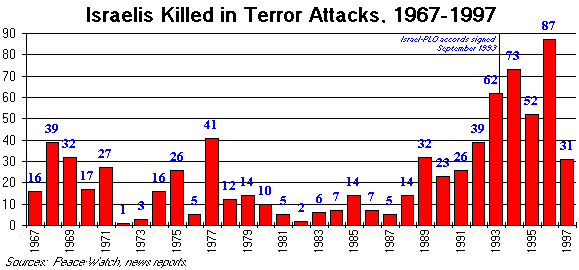

The chart above shows the number of Israelis killed in terror attacks in each of the 30 years since 1967, when Israel took control of Judea and Samaria ("the West Bank") and Gaza.
One might have thought the rate of terrorism would have fallen since Israel reached the famous "Oslo accords" with the PLO in September 1993. The reverse has been the case.
Which were the four worst years for terror
fatalities since 1967? In order: 1996, 1994, 1993 and 1995. Each of the
years since the accords was worse than any of the years before them. The
trend has changed since the May 1996 election of the Likud party coalition
under Binyamin Netanyahu.
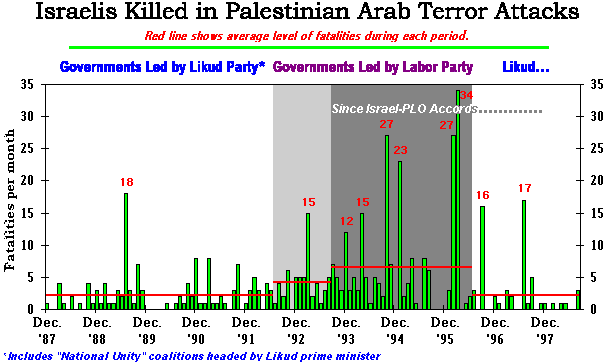
2. After Israel's June 1992 elections, a new governing coalition was formed, led by the left-wing Labor party. It began to relax the tight security policies of the previous right-wing Likud-led government. An upsurge in terrorism followed soon thereafter.
3. Terrorism shot up again after September 1993, when the Labor government broke with longstanding Israeli policy by brokering a deal with the PLO terrorist organization. In the 30 months after that date, more Israelis were killed by terrorists (213) than in the preceding decade (209 from January 1983 to September 1993).
4. Since the end of a wave of mass suicide bombings in February-March 1996, and since the election in May 1996 of a new government led by the Likud party, the level of terrorism has fallen dramatically. There have been far fewer successful major terrorist attacks, and fatalities in lower-level terrorism have also dropped significantly.
Sources: Peace Watch, Shalem Center, Yesha Council, Jewish Action Initiative, news reports.
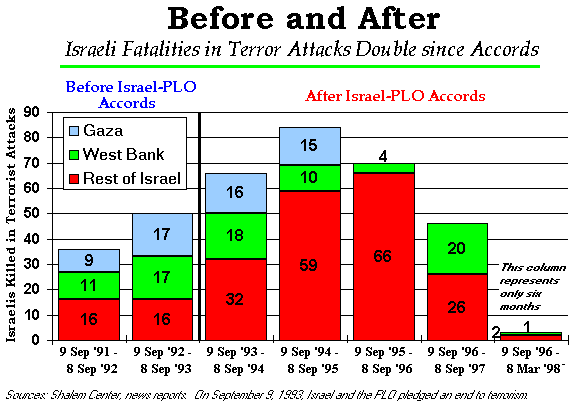
When the first Israel-PLO agreement was signed in September 1993, Israeli leaders promised that a drop in terrorist activity would follow. The reverse has occurred. As the chart above shows, more Israelis were killed in terrorist attacks after the accords than before.
In fact, there were over twice as many Israeli terror fatalities in the year from Sep. 1994 - Sep. 1995 as in Sep. 1991 - Sep. 1992. Overall, Israel suffered 73% more terror fatalities in the two years after the 1993 deal than in the two years before it.
The period since the Israel-PLO accords has seen the highest level of terrorist killings in the history of the state of Israel.
Furthermore, as the graph indicates, the increase in terror has taken place mainly within Israel's pre-1967 boundaries, not in Judea and Samaria ("the West Bank") or Gaza. Suicide bomb attacks in and near Tel Aviv, Jerusalem and Netanya have brought terror to where most Israelis live.
Since the June 1996 inauguration of Prime Minister Binyamin Netanyahu's center-right government, there has been a substantial drop in terror fatalities, with figures returning to their pre-1993 levels.
Source: News reports, press releases by Peace Watch, a nonpartisan watchdog group monitoring compliance with the Israel-PLO accords, and the Shalem Center - National Policy Institute.
Note: Figures include attacks on Israeli civilians and soldiers in areas within Israel's security responsibility. Thus, attacks on Israeli targets in Buenos Aires or other parts of the world are not included; neither are attacks in southern Lebanon or by the Lebanese Hizbullah.
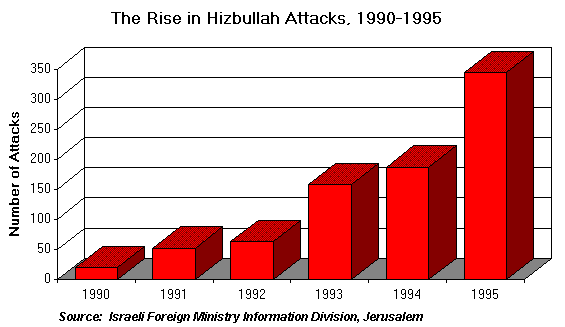
Why did Israel launch its April 1996 "Operation Grapes of Wrath" against the Hizbullah force in southern Lebanon? The graph above shows part of the picture. Attacks by Hizbullah against Israeli targets have risen dramatically over the past few years, putting increasing pressure on Israel's northern towns and on the soldiers defending the northern border.
Hizbullah activity had already increased substantially by 1993, when Israel struck back with "Operation Accountability." The unwritten understandings reached to end that operation, however, proved insufficient. Hizbullah continued to step up its attacks, backed by Iran and Syria.
In 1995 Hizbullah attacks nearly doubled again, and by April 1996 the situation had become unbearable, prompting Israel's latest operation to defend its northern border.
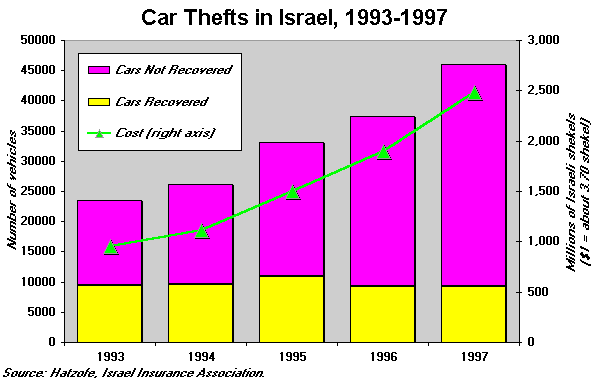
Israel now has the highest rate of car theft in the world, according to the Israel Insurance Association. The chart above shows the number of cars stolen each year since 1993 (vertical bars, left axis), along with the cost to insurance companies (green line, right axis).
The increase in car thefts was fueled by the Israel-PLO accords, which were signed in September 1993 and took effect in May 1994. According to the London-based Sunday Telegraph (5 July 1998), Palestinian and Israeli car thieves cooperate, and Israeli police say many of the cars end up in Palestinian-controlled areas. According to one Palestinian car thief, "I can have any car you want within a few hours, I'll just call the Israelis I work with."
"The problem of stolen cars has increased to a real crisis," said Israel Insurance Association spokesman Shmuel Malkis. The Israeli cabinet has even approved a plan to fight the problem. "This is a blight on the country," said Public Security Minister Avigdor Kahalani.
Under the 1993 Israel-PLO accords, the Palestinian Authority was granted jurisdiction over parts of the West Bank and Gaza, putting those areas off-limits to Israeli police. Criminals soon began moving stolen cars into the self-rule areas to evade the Israeli authorities.
Israeli officials believe their Palestinian Authority counterparts are ignoring the problem, pointing to cases in which Palestinian officials have been found driving stolen cars.
The statistics in the above chart were reported by Israeli newspaper Hatzofe (13 March 1998), based on figures from the Israel Insurance Association.
In 1993, some 23,000 cars were stolen, 40 percent of which were recovered, costing insurance companies about 950 million Israeli shekels, or about $260 million. By 1997, nearly 46,000 cars were stolen, but only 20 percent were recovered, with costs totalling nearly 2.5 billion shekels. While the number of thefts has risen rapidly, the number of vehicles recovered has stayed about even.
Over the five years (1993-97), over 166,000 cars were stolen, 71 percent of which were never found. Costs totaled almost 8 billion shekels. These cost estimates do not appear to include secondary costs to the economy, such as the 28 percent rise in insurance premiums and increased spending on vehicle security devices.
Overall, 30 out of every thousand vehicles in Israel will be stolen sooner or later, compared with 8 to 12 per thousand in the United States and western Europe.
The Israel-PLO agreements took effect in May 1994, with the Palestinian Authority taking control of the Gaza and Jericho areas. A stolen car industry then began to develop in Jericho. In December 1995, the main Arab cities in Judea and Samaria (the West Bank) were all turned over to the PA, except for Hebron, which followed suit in January 1997. By 1997, car thefts had doubled since 1993, and the number of vehicles never recovered had increased by two and a half times.
It is rarely realized, however, the potential danger such rockets could pose to Israel's main population centers should they fall into the wrong hands.
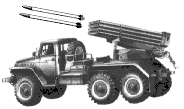 The Katyusha Rocket "Multiple Rocket Launcher" BM-21 pictured here could
be easily taken apart and smuggled into a "demilitarized" Palestinian state.
Individual Katyushas can be launched from a pipe using just a car battery.
The Katyusha Rocket "Multiple Rocket Launcher" BM-21 pictured here could
be easily taken apart and smuggled into a "demilitarized" Palestinian state.
Individual Katyushas can be launched from a pipe using just a car battery.
The rockets on this truck have a
range of 12.7 miles / 20.4 km. Katyushas can easily carry chemical
warheads. One full salvo of rockets from this truck would fire the explosive
equivalent to four Iraqi-type Scud missiles, which were launched into Israel
during the 1991 Gulf War. No apartment in Tel Aviv would be safe, as the
map below demonstrates.
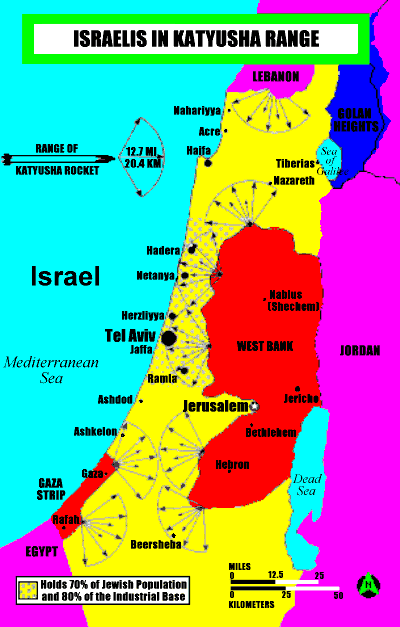
The speckled region to the left is the Tel Aviv metropolitan area, which houses some 70% of Israel's Jewish population and 80% of the country's industrial base. The West Bank is a mountainous region overlooking the Mediterranean coastal plain and Gaza is a seaside district with its own port. If Israel relinquishes military control over these regions, it will be impossible to prevent the smuggling of weapons such as the Katyusha. The potential implications are clear.
(Information and map courtesy of Mark Langfan)
Source: Information Regarding Israel's Security (IRIS): Graphs of Terror and Crime